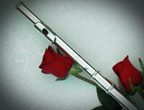 The two most important musical selections you’ll make for your wedding (unless yours will be a completely non-traditional wedding) will be the processional(s), for the entrance of the wedding party and the bride, and the recessional for your walk back up the aisle at the end of the ceremony. If you already know which pieces you’d like, then no need to read further! If not, read on!
The two most important musical selections you’ll make for your wedding (unless yours will be a completely non-traditional wedding) will be the processional(s), for the entrance of the wedding party and the bride, and the recessional for your walk back up the aisle at the end of the ceremony. If you already know which pieces you’d like, then no need to read further! If not, read on!
The first question to ask yourself is whether your choices are likely to be the traditional ones, or ones that will be a little different – more unique. Many people know the answer to this right away, one way or another. In case you’re a little unsure about this question, I’ll toss around a few thoughts.
For some couples the thought of getting married without hearing the familiar “Wedding March” by Mendelssohn at the end would be a little like Christmas with no Christmas Carols, a birthday party without singing “Happy Birthday,” breakfast without orange juice, Hanukkah without latkes – it just wouldn’t feel right! If this is your feeling, that’s great! I’ve known musicians who try to talk couples out of the traditional choices, into something more unique, something they regard as more interesting. I believe that if you like the traditional choices and the feelings that go along, then go for it and enjoy! If not, that’s also great. Whatever makes you feel just the way you want to feel on your day is the right call.
For the true tradition lover, you’ll likely gravitate toward either “Bridal Chorus” by Wagner or “Canon in D” by Pachelbel for the processionals (some even choose both – Pachelbel for the wedding party and Wagner for the bride) and “Wedding March” by Mendelssohn for the recessional. (you can click here to access a page where you can hear recordings of these pieces).
Without a doubt, Mendelssohn’s “Wedding March” is the piece I’ve played most frequently at weddings. Even less traditional couples often want the Mendelssohn for the recessional. In my experience, the Pachelbel Canon is the most popular choice for the bride’s processional, with the Wagner “Bridal Chorus” coming in a close second.
All three of these choices work well for any instrument combination, are easy to walk to, and will give you that traditional feeling of following the steps of many that have gone before. If this is the route you choose, then your decision making is a breeze! I’ll be sharing some thoughts about the Pachelbel Canon in particular in a future post, and spelling out some of the stylistic differences between common processional choices, as well as suggesting some other popular choices you may wish to consider for your wedding party’s processional. So if those are a question mark, stay tuned!
But what if you really want your wedding to be a little different from the others? Something that reflects your style in a unique and different way? Or you just can’t handle the thought of hearing that same old tune for your OWN wedding, or just plain don’t like those tunes? Good news – there are many, many great options. The only potential bad news is that it may mean a little more research and time spent on the decision making process. On the other hand, if you’ve got the perfect piece already in mind – great! Just bear in mind that some pieces work better for some instrument combinations than others – and some may not be workable for a particular instrument combination. I’ll be addressing the topic of “less common repertoire choices” for ceremony music in future blog posts, and am hoping that this might make the decision making a little simpler. In the meantime, an experienced wedding musician should be able to ask you the right questions to steer you in the right direction and make the suggestions you’d be most happy with. I’ll be including some of those question possibilities in future posts.


